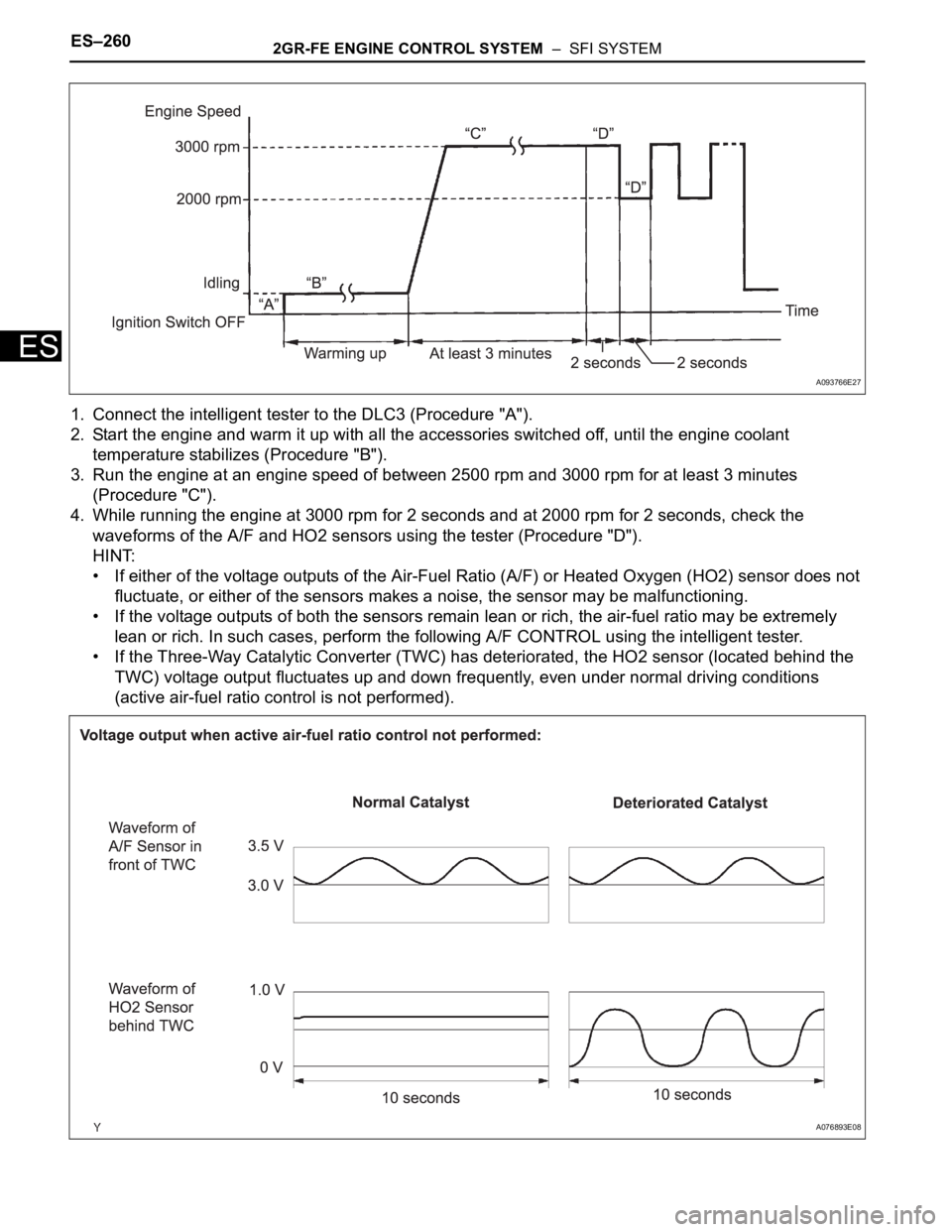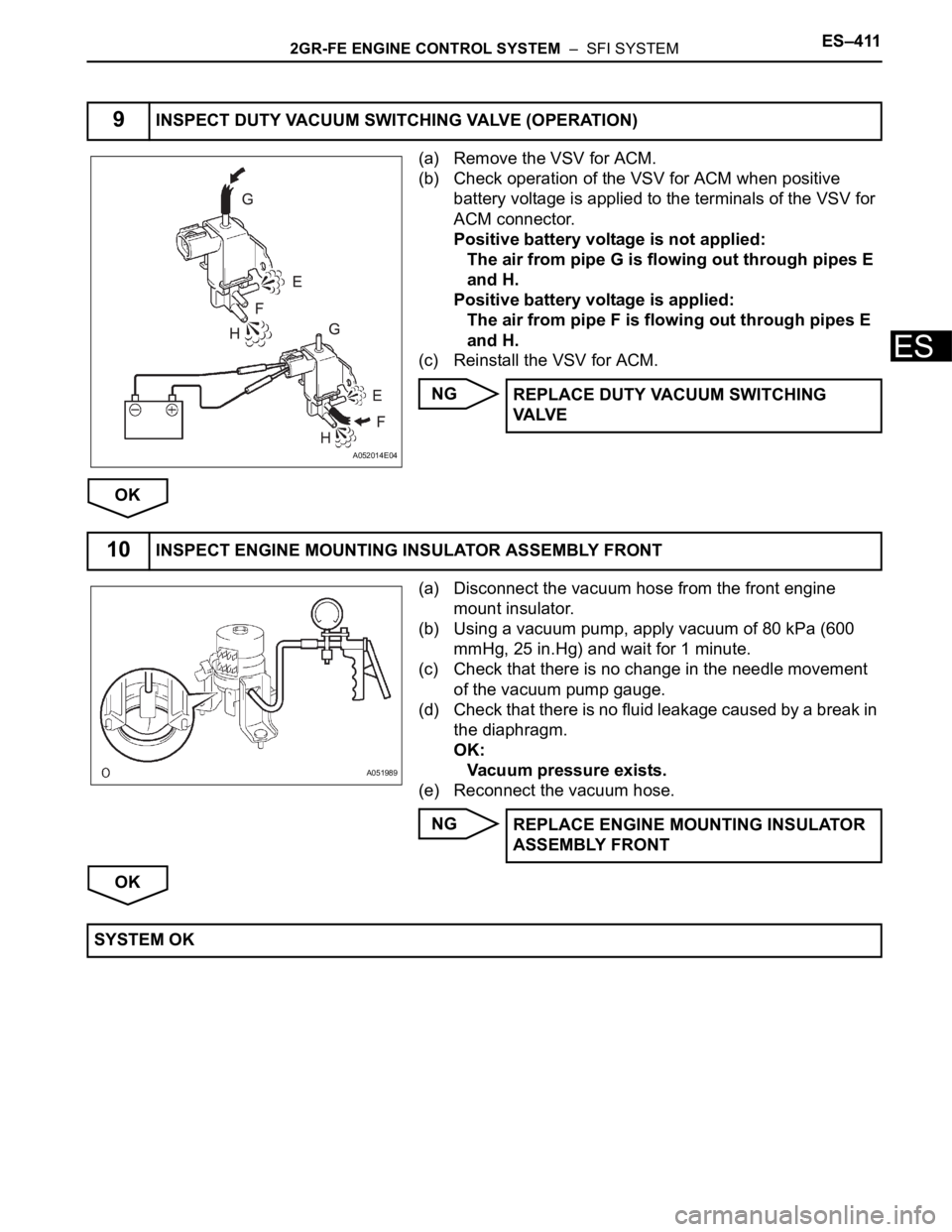Page 328 of 3000

ES–2602GR-FE ENGINE CONTROL SYSTEM – SFI SYSTEM
ES
1. Connect the intelligent tester to the DLC3 (Procedure "A").
2. Start the engine and warm it up with all the accessories switched off, until the engine coolant
temperature stabilizes (Procedure "B").
3. Run the engine at an engine speed of between 2500 rpm and 3000 rpm for at least 3 minutes
(Procedure "C").
4. While running the engine at 3000 rpm for 2 seconds and at 2000 rpm for 2 seconds, check the
waveforms of the A/F and HO2 sensors using the tester (Procedure "D").
HINT:
• If either of the voltage outputs of the Air-Fuel Ratio (A/F) or Heated Oxygen (HO2) sensor does not
fluctuate, or either of the sensors makes a noise, the sensor may be malfunctioning.
• If the voltage outputs of both the sensors remain lean or rich, the air-fuel ratio may be extremely
lean or rich. In such cases, perform the following A/F CONTROL using the intelligent tester.
• If the Three-Way Catalytic Converter (TWC) has deteriorated, the HO2 sensor (located behind the
TWC) voltage output fluctuates up and down frequently, even under normal driving conditions
(active air-fuel ratio control is not performed).
A093766E27
A076893E08
Page 330 of 3000

ES–2622GR-FE ENGINE CONTROL SYSTEM – SFI SYSTEM
ES
• Following the A/F CONTROL procedure enables technicians to check and graph the voltage
outputs of both the A/F and HO2 sensors.
• To display the graph, select the following menu items on the tester: DIAGNOSIS /
ENHANCED OBD II / ACTIVE TEST / A/F CONTROL / USER DATA / AFS B1S1 and O2S
B1S2 or AFS B2S1 and O2S B2S2. Press the YES button and then the ENTER button. Then
press the F4 button.
INSPECTION PROCEDURE
HINT:
Read freeze frame data using the intelligent tester. The ECM records vehicle and driving condition
information as freeze frame data the moment a DTC is stored. When troubleshooting, freeze frame data
can be helpful in determining whether the vehicle was running or stopped, whether the engine was
warmed up or not, whether the air-fuel ratio was lean or rich, as well as other data recorded at the time of
a malfunction.
(a) Connect the intelligent tester to the DLC3.
2• A/F sensor
• A/F sensor
heater
• A/F sensor
circuit
3• HO2 sensor
• HO2 sensor
heater
• HO2 sensor
circuit
4•Fuel pressure
• Gas leakage
from exhaust
system
(Air-fuel ratio
extremely lean
or rich)
1CHECK ANY OTHER DTCS OUTPUT (IN ADDITION TO DTC P0420 AND/OR P0430)
CaseA/F Sensor (Sensor 1)
Output VoltageHO2 Sensor (Sensor 2)
Output VoltageMain Suspected
Trouble Area
Page 332 of 3000

ES–2642GR-FE ENGINE CONTROL SYSTEM – SFI SYSTEM
ES
Lean: During A/F CONTROL, the A/F sensor output
voltage (AFS) is consistently more than 3.35 V, and the
HO2 sensor output voltage (O2S) is consistently less
than 0.4 V.
Rich: During A/F CONTROL, the AFS is consistently less
than 3.0 V, and the O2S is consistently more than 0.55 V.
Lean/Rich: During A/F CONTROL of the ACTIVE TEST,
the output voltage of the HO2 sensor alternates
correctly.
B
C
A
OK:
No gas leakage.
NG
OK
Rich Lean/Rich A/F sensor malfunction - A/F sensor B
Lean/Rich Lean HO2 sensor malfunction -• HO2 sensor
• Gas leakage from
exhaust systemC
Lean/Rich Rich HO2 sensor malfunction -• HO2 sensor
• Gas leakage from
exhaust systemC
Lean Lean Actual air-fuel ratio lean May occur• Extremely rich or lean
actual air-fuel ratio
• Gas leakage from
exhaust systemA
Rich Rich Actual air-fuel ratio rich -• Extremely rich or lean
actual air-fuel ratio
• Gas leakage from
exhaust systemA Status AFS
B1S1 or AFS
B2S1Status O2S
B1S2 or O2S
B2S2A/F Condition and A/F and
HO2 Sensor ConditionsMisfires Suspected Trouble Areas Proceed to
REPLACE AIR FUEL RATIO SENSOR
CHECK AND REPLACE HEATED OXYGEN
SENSOR, AND CHECK AND REPAIR
EXHAUST GAS LEAKAGE
3INSPECT FOR EXHAUST GAS LEAK
REPAIR OR REPLACE EXHAUST GAS
LEAKAGE POINT
REPLACE THREE-WAY CATALYTIC CONVERTER (EXHAUST MANIFOLD LH OR RH)
Page 334 of 3000
ES–4062GR-FE ENGINE CONTROL SYSTEM – SFI SYSTEM
ES
WIRING DIAGRAM
INSPECTION PROCEDURE
(a) If the hose is damaged, replace the vacuum hose
assembly.
(b) Check the air and vacuum hoses for looseness,
disconnection and blockage.
NG
OK
1CHECK VACUUM HOSES
A136867E18
G042514E04
REPAIR OR REPLACE VACUUM HOSES
Page 335 of 3000
2GR-FE ENGINE CONTROL SYSTEM – SFI SYSTEMES–407
ES
(a) Start the engine.
(b) Disconnect the vacuum hose from the air cleaner cap.
(c) Check that the disconnected port located on the vacuum
tank applies suction to your finger.
OK:
Vacuum pressure exists.
(d) Reconnect the vacuum hose.
NG
OK
(a) Connect the oscilloscope between terminals ACM and
E1 of the E9 and E11 ECM connectors.
(b) Warm up the engine to normal operating temperature.
(c) Turn the A/C switch on.
(d) Measure the voltage according to the value(s) in the
table below.
Standard voltage
OK
NG
2CHECK VACUUM
G041079
CHECK AND REPLACE VACUUM SOURCE
AND HOSES
3INSPECT ECM
A114640E06
Condition Voltage
Shift position is D, and engine speed is 850 rpm
or lessPulse generation
Shift position is D, and engine speed is 950 rpm
or more9 to 14 V
Shift position is P 9 to 14 V
Go to step 9
Page 336 of 3000
ES–4082GR-FE ENGINE CONTROL SYSTEM – SFI SYSTEM
ES
(a) Disconnect the V3 VSV for ACM connector.
(b) Measure the resistance according to the value(s) in the
table below.
Standard resistance:
19 to 21
at 20C (68F)
(c) Reconnect the VSV for ACM connector.
NG
OK
(a) Check the wire harness between the VSV for ACM
connector and the ECM connector.
(1) Disconnect the V3 VSV for ACM connector.
(2) Disconnect the E9 ECM connector.
(3) Measure the resistance according to the value(s) in
the table below.
Standard resistance:
Check for open
Check for open
(4) Reconnect the ECM connector.
NG
OK
4INSPECT DUTY VACUUM SWITCHING VALVE (RESISTANCE)
C058536E28
REPLACE DUTY VACUUM SWITCHING
VA LV E
5CHECK HARNESS AND CONNECTOR (VSV FOR ACM - ECM)
A163536E01
Tester Connection Specified Condition
VSV for ACM (V3-2) - ACM (E9-3) Below 1
Tester Connection Specified Condition
VSV for ACM (V3-2) or ACM (E9-3) - Body ground 10 k
or higher
REPAIR OR REPLACE HARNESS OR
CONNECTOR (VSV FOR ACM - ECM)
Page 338 of 3000
ES–4102GR-FE ENGINE CONTROL SYSTEM – SFI SYSTEM
ES
(a) Check the wire harness between the VSV for ACM and
the EFI relay.
(1) Remove the EFI relay from the engine room junction
block.
(2) Measure the resistance according to the value(s) in
the table below.
Standard resistance:
Check for open
(3) Reconnect the VSV for ACM connector.
(4) Reinstall the EFI relay.
NG
OK
8CHECK HARNESS AND CONNECTOR (VSV FOR ACM - EFI RELAY)
A163531E02
Tester Connection Specified Condition
VSV for ACM (V3-1) - EFI relay terminal (3) Below 1
REPAIR OR REPLACE HARNESS OR
CONNECTOR (VSV FOR ACM - EFI RELAY)
CHECK ECM POWER SOURCE CIRCUIT
Page 339 of 3000

2GR-FE ENGINE CONTROL SYSTEM – SFI SYSTEMES–411
ES
(a) Remove the VSV for ACM.
(b) Check operation of the VSV for ACM when positive
battery voltage is applied to the terminals of the VSV for
ACM connector.
Positive battery voltage is not applied:
The air from pipe G is flowing out through pipes E
and H.
Positive battery voltage is applied:
The air from pipe F is flowing out through pipes E
and H.
(c) Reinstall the VSV for ACM.
NG
OK
(a) Disconnect the vacuum hose from the front engine
mount insulator.
(b) Using a vacuum pump, apply vacuum of 80 kPa (600
mmHg, 25 in.Hg) and wait for 1 minute.
(c) Check that there is no change in the needle movement
of the vacuum pump gauge.
(d) Check that there is no fluid leakage caused by a break in
the diaphragm.
OK:
Vacuum pressure exists.
(e) Reconnect the vacuum hose.
NG
OK
9INSPECT DUTY VACUUM SWITCHING VALVE (OPERATION)
A052014E04
REPLACE DUTY VACUUM SWITCHING
VA LV E
10INSPECT ENGINE MOUNTING INSULATOR ASSEMBLY FRONT
A051989
REPLACE ENGINE MOUNTING INSULATOR
ASSEMBLY FRONT
SYSTEM OK